- Make It Yourself Lavender Heart-Shaped Bath Bombs!
- 20 Things You Never Knew About “Down There”
- 12 Best Foods For Those Suffering From Arthritis Pain
- 12 Personal Hygiene Mistakes Almost Everyone Makes (Mom Never Told You About #4!)
- 15 Medicinal Plants And Herbs From The Cherokee People
- 12 Mind-Blowing Benefits Of Drinking Coconut Water During Pregnancy
- 12 Outstanding Winter Foods That Won’t Fatten You Up Like A Christmas Turkey
Top 10 GMO Foods to Avoid
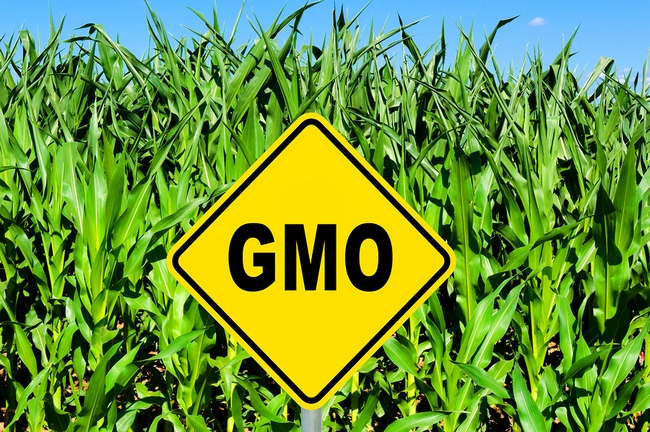
Photo credit: bigstock
About 20 years ago, a little company (now owned by the giant Monsanto) created a GMO tomato called Flavr Savr, one of the first GMO foodstuffs approved for consumption in the US. Since that time, farmers all over the world have been using more and more of these genetically modified organisms every single year.
Due to social media and internet health sites, such as Naturalon, the practice of using GMO foods has come under some intense scrutiny. Health activists everywhere are concerned about future human health problems, as well as environmental damage. People everywhere are demanding that foods that have GMO contents should be labeled as such. People have a right to know what they are eating!
A ballot measure in California that would have mandated the labeling of GMO products, failed in 2012. A similar measure lost in Washington State. In both cases, the largest GMO makers, DuPont, Dow Chemical, and Monsanto, all provided funds for ads to deceive and confuse voters.
Many people believe that GMOs are something new, but the fact is, Americans have been consuming products that contain GMO ingredients for years. Although Big Agri continues to tell us that they are safe, they also continue avoiding labels. If their foods are so safe, why are they trying to hide the fact that you are eating them? There are increasing amounts of research that show that GM foods damage ecosystems, cause financial chaos for farmers, cause harm to humans, and release trans genes that could transfer to other life forms, which would have disastrous consequences.
Sometimes trying to avoid consuming GMO products is difficult. If you have a hard time finding foods that aren’t GMO at your regular supermarket, try farmers’ markets, health food stores, and organic food stores. You could also start your own garden where you can be sure your food is not GMO and is completely organic.
Take a look at the top 10 most popular foods that contain GMOs so you can avoid these products in the future.
1. Zucchini and Yellow Squash
These are closely related cousins. Sometimes you will see yellow squash listed as yellow Italian squash or even yellow zucchini. Many people eating gluten free diets, or those who wish to avoid processed foods such as pasta, are using zucchini to make their own type of “pasta.” What many of them fail to realize is that unless they are very careful about where they buy their produce, they are most likely using GMO zucchini in their little spiral making machines. Remember that GM foods do not have to be labeled as such, so it’s pretty easy to consume these foods without knowing it. To avoid this, it’s best to buy your foods from a farmers’ market where you can talk to the farmer who grew it. It’s almost a given that these types of farmers grow organically, and they won’t be using GM seeds, but if you have any doubt, ask them. Most farmers are more than happy to tell you all about the food they have worked so hard to grow.

Photo credit: bigstock
2. Corn
Because corn is used in so many foods, it’s probably one of the most famous GMO products. Avoiding corn is a no-brainer. If you have watched any documentaries on food production, you know that corn is very highly modified. About half of all farms in America grow corn for Monsanto. A great deal of this corn is meant for human consumption. GMO corn has been tied to a long list of health issues, including weight gain, organ disruption, and reproductive issues.
SEE ALSO: GMOs Have Never Been Shown to be Safe
One study done in 2009 in Brazil showed that female rats there were fed GM foods for 15 months had huge changes in their reproductive cycles as well as in their uteruses. It caused changes such as an excessive production of estrogen, progesterone, and a hormone that stimulated the follicles in the body. It also showed damage to the pituitary gland, gastrointestinal problems, and chronic fatigue.
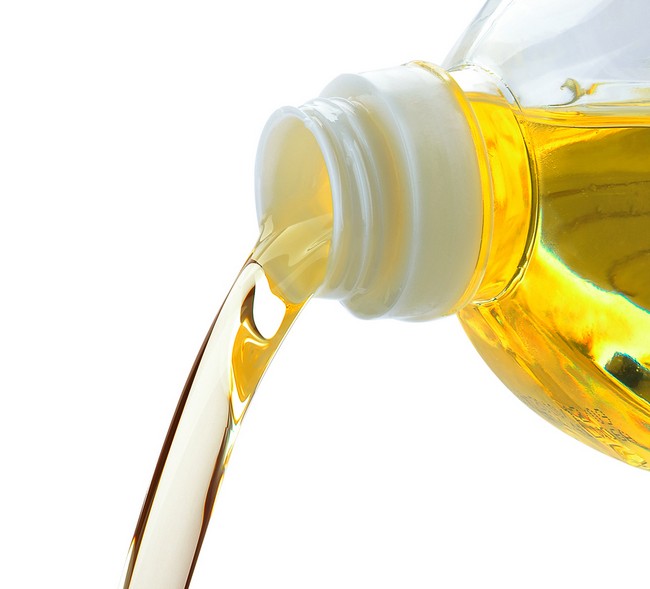
Photo credit: bigstock
3. Canola Oil
Probably one of the most chemically altered foods in the USA today, canola oil comes from rapeseed and is put through a long process involving a multitude of chemicals to extract what we call canola oil.
GM rapeseed is just as stinky as the original rapeseed. In order to sell you this product, they need to add deodorizers to this oil. It goes through a process of bleaching, caustic refinement, degumming, and is then deodorized. By the time this process is done, almost all omega-3 fatty acids have been removed from this oil and replaced, instead, by those trans-fatty acids everyone knows they should avoid.
If the truth were told, canola oil is extremely delicate and unstable oil that goes rancid extremely quickly. The problem is, since this oil contains deodorizers, you will never know if you are eating rancid oil or not! Now that is a truly disgusting thought!
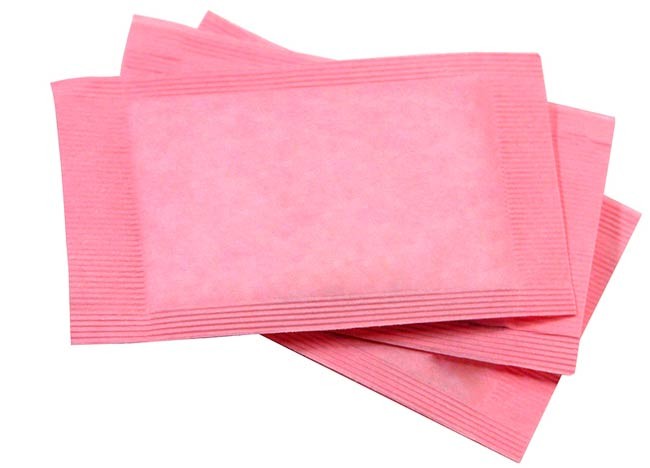
Photo credit: bigstock
4. Aspartame
Although this is said to be an “artificial” sweetener, it starts off its life as genetically modified bacteria. It’s true! Aspartame starts off its life as GM bacteria (E.coli) which is kept well fed until it excretes a protein that has the aspartic amino acid that is needed to make aspartame. So, in essence, a part of aspartame is the poop from a GM organism. Yuck.
Numerous studies have found a dangerous link between the consumption of aspartame and the development of brain tumors. Aspartame breaks down into DKP in your stomach, which causes the growth of brain tumors.
Although many people with diabetes drink diet sodas that contain aspartame in hopes it will lower their blood sugar, it actually has been shown in studies to do the exact opposite. It also aggravates conditions related to diabetes such as neuropathy, cataracts, retinopathy, and gastro paresis. In fact, for some people it’s even been shown to cause seizures, which are often mistaken for insulin reactions.
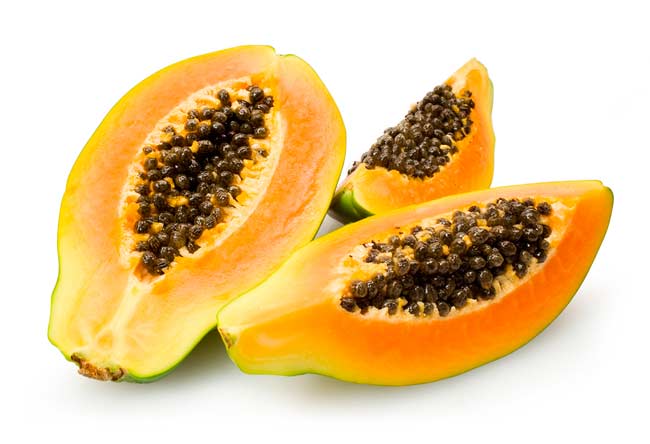
Photo credit: bigstock
5. Papayas
Like tomatoes, papayas are one of the first GMO foods ever created. If you get your papayas from Hawaii, you have been eating GMO foods since 1999. The European Union will not accept these fruits, but the USA has no problem selling them to you.
These fruits were made to be resistant to the papaya ringspot virus, a constant problem in Hawaii. Although this might sound good, and these papayas certainly are large and good looking on supermarket shelves, all is not well in paradise.
With the growing concern over GMO foods, many people and markets are rejecting these fruits. Japan does not allow their importation, and they have been happily exporting their papayas to Europe and the USA. American officials are trying to “force” Japan to sell these GMO papayas and, as of now, Japan says they will only do so if they are labeled as GMO, which American growers balk at doing. If their fruits are so safe, why do they have a problem with labeling them?
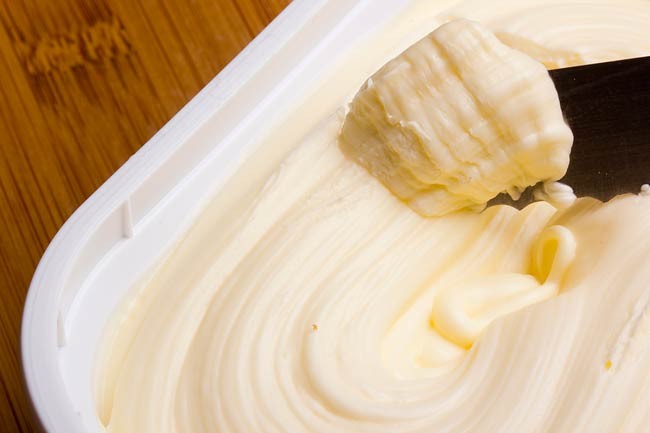
Photo credit: bigstock
6. Margarine and Shortening
These are all made from GMO vegetable oil blends (such as corn or soybean oil) or canola oil. Margarine and vegetable shortening are probably the worst ways Americans consume GMO foods.
Our bodies are made up of about 97 percent monounsaturated and saturated fats and only 3 percent polyunsaturated fats. One half of that 3 percent is made up of Omega-3. These GMO vegetable oils are made of extremely unhealthy levels of polyunsaturated fats. Polyunsaturated fats are unstable and oxidize easily. Simple exposure to light will cause them to oxidize. Oxidized fats in the body cause the mutation of cells (cancer) and/or inflammation.
Consumption of these GMO vegetable based oils deplete the body of healthy antioxidants, vitamin E, and cause problems with the production of hormones. In fact, the consumption of vegetable oils, shortening, and margarine cause so many health problems, it’s impossible to list all of them in this article. Just a few of them, however, are a suppression of the immune system, fatty liver, heart disease, weight gain, and cancer.
Use all natural organic butter or coconut oil instead.
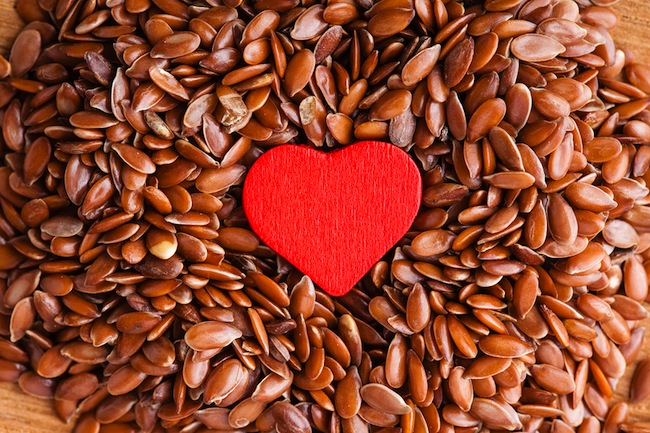
Photo credit: bigstock
7. Flaxseed/Flaxseed Oil
If you like to eat ground flaxseed or if you take flaxseed oil supplements, be sure you choose only certified organic flaxseeds and/or flaxseed oil. Even this previously healthy grain has been contaminated with GMO seeds.
Flaxseed and flaxseed oil is used in great deal more than supplements. More and more foods are made with this oil because it contains excellent nutritional compounds. The demand for flax is increasing at a substantial rate and there is no end in sight.
Read labels carefully. If your product was made in America or Canada and it contains flaxseed or its oil, it’s most likely GMO unless it states otherwise. The European Union rejects all foods and supplements made with GMO flaxseed or its oil. So if your product was made in France, for example, you know that it does not contain GMO flaxseed or GMO flaxseed oil. Always check your sources and buy only certified organic, non GMO flaxseed oil supplements or products.
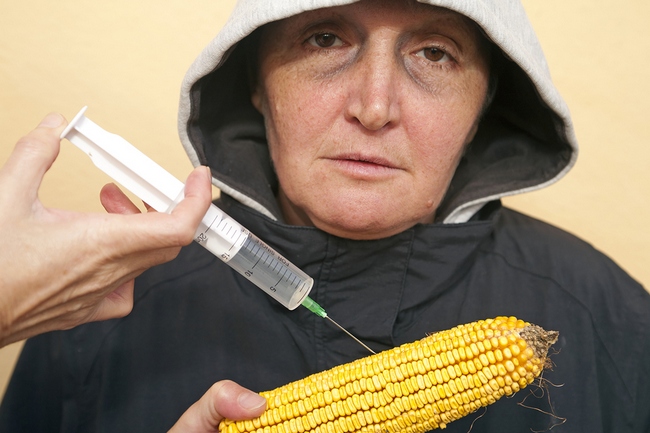
Photo credit: bigstock
8. High Fructose Corn Syrup (HFCS)
Of course, HFCS is made from GMO corn. This is a dangerous product that should be avoided at all costs.
As part of the process that is necessary to make this product, the glucose and fructose, which are naturally inseparable, now become separated. This lets fructose go directly into your liver. This will lead to a fatty liver, one of the most common diseases affecting Americans today. This is a precursor to diabetes, cancer, dementia, stroke, and heart attacks.
On top of the GMO concerns are the chemical toxins that are used to make HFCS. This product contains small amount of mercury, along with a ton of chemicals that have been linked to certain cancers and other types of health problems.
Even if you want to ignore all of the above, one thing cannot be denied: there is not a single product (food) that contains HFCS that is healthy for you. The worst of the junk foods on the planet all contain HFCS. Don’t eat things that are low in nutrition and are known to cause health problems and cancer. Steer clear of anything that contains this ingredient.
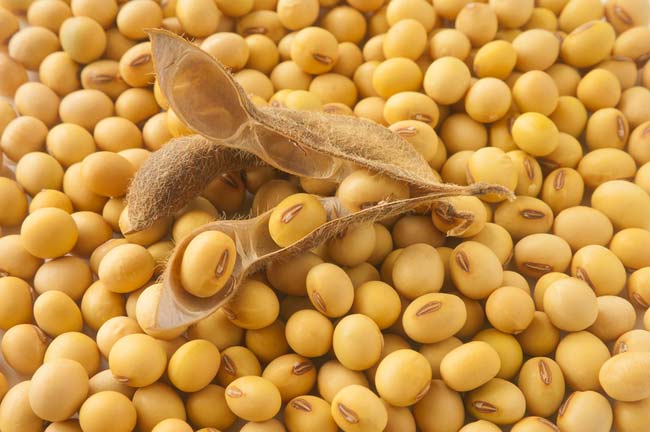
Photo credit: bigstock
9. Soy
GMO soybeans are found in most vegetarian products, tofu, soy flour, soybean oil, and many, many other food products. It’s been estimated that an astounding 90 percent of soy is now GMO. This type of soy has been modified to resist herbicides. Monsanto has a short leash on the soybean market, as they control all seeds and growing procedures.
The fatty acids in soy are mostly omega-6 fatty acids. This is a problem because too much of this type of fatty acid can lead to inflammation everywhere in the body. Although soy can be rich in micronutrients, they also contain high amounts of phytates. Phytates block the body from absorbing many minerals.
Unfortunately, soy also contains large amount of phytoestrogens, which are plant-based substances that active estrogen receptors in humans. This is not a good thing, as they interrupt the normal function of hormones.
Even if you don’t eat tofu or think you are eating soy, look again. Many products actually use soy as a base without you ever being aware of it. Again, read labels to be sure you know what you are consuming.
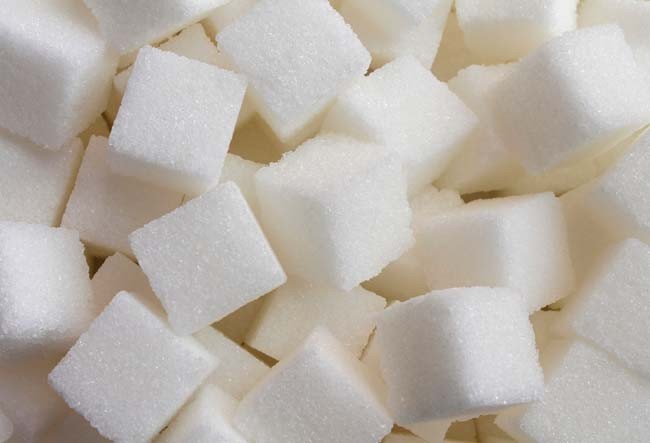
Photo credit: bigstock
10. Sugar
GMO sugar beets were introduced in America in 2009. Most products that state that they are sweetened with “sugar” come from sugar beets unless they say ‘pure cane sugar.’
Too much sugar in your diet is bad for your health anyway, but when you add to that GMO sugar, it’s double trouble! GMO sugar beets are infused at the genetic level with glyphosate (RoundUp). Yes, that same herbicide that you see for sale in garden centers. With every bite, you are eating RoundUp. Although no one would serve a bottle of this herbicide along with dinner or dessert, that is essentially what you are doing when you serve GMO sugar beets or any GMO product. RoundUp has been known to cause cancer and is killing off the bee population in America.
YOU MIGHT ALSO LIKE: GMO Bananas and Humans: Untested, Unneeded, and Unwise
Read your labels with great care. If it doesn’t say cane sugar, it’s GMO. This goes for table sugar, brown sugar, or powdered sugar. This is why you might see several packages on your supermarket shelf proudly stating in large type “Made with Pure Cane Sugar.” They want you to know what you are buying. In today’s GMO world, that is priceless.
Sources:
Top 20 GMO Foods and Ingredients to Avoid by Dr. Edward F. Group, DC, ND, DACBN, DABFM




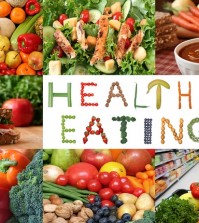





























Penny Fuentes
Dec 30, 2014 at 10:45 pm
We can’t even depend on our government to protect us from garbage that other nations will not allow in their country.
anon
Jan 1, 2015 at 6:28 am
Our government is subsidizing and creating the garbage. Also see: Lyme disease.